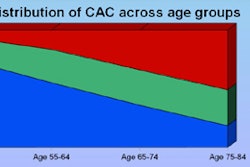A new Danish study has concluded that coronary artery calcium (CAC) levels are associated with living in city centers where air pollution is elevated.
Urban center residents were 80% more likely to develop CAC, which was detected at CT, compared to individuals living in other areas. Older individuals, smokers, and diabetics also faced higher risks, the authors concluded.
The researchers interviewed 1,225 men and women ages 50 to 60 years without symptoms of heart disease. At noncontrast CT, 43% showed evidence of coronary artery calcium (Journal of Internal Medicine, May 2012, Vol. 271:5 pp. 444-450).
Each participant completed a questionnaire detailing medical conditions, medications, smoking habits, and family history of heart disease. Clinicians collected height, weight, blood pressure, and blood test information, and patients underwent cardiac CT scans.
The place where a person lives is often used as a surrogate for exposure to air pollution in research, said Dr. Jess Lambrechtsen, from Svendborg Hospital, in a statement accompanying the study's release. Even after adjusting for demographic and clinical variables, where people lived was independently associated with CAC, and CAC levels were highest in people living in city centers, he said. Key findings included the following:
- Development of CAC for those living in city centers, rather than in urban or rural areas, was 69% versus 56% in men, 42% versus 30% in women, 48% versus 32% in 50-year-olds, and 61% versus 53% in 60-year-olds, respectively.
- Men were more than three times as likely to develop CAC than women, with a 220% higher odds risk.
- 60-year-olds were approximately twice as likely to develop CAC as 50-year-olds (120% higher odds risk). Smokers were also more likely than nonsmokers (90% higher odds risk), and people with diabetes were more likely than those without diabetes (100% higher odds risk).
- High cholesterol raised the odds of developing CAC by 60%, and high blood pressure and a family history of heart disease both raised the odds by 50%.
Living in a city center and traditional risk factors for heart disease were independently associated with the presence of CAC in asymptomatic middle-aged subjects, the authors concluded.




















